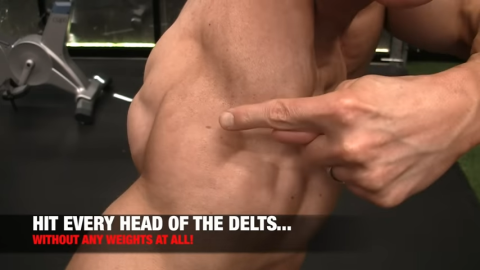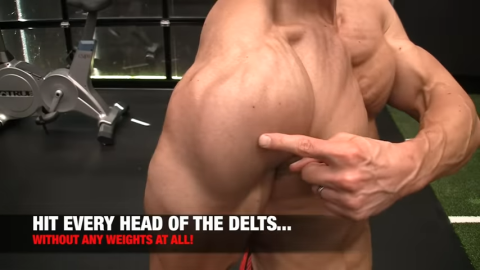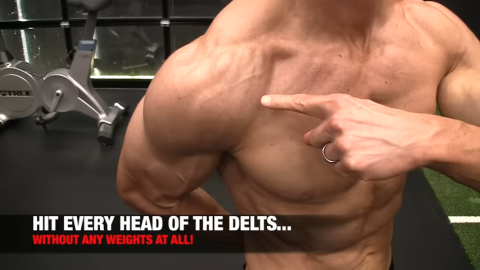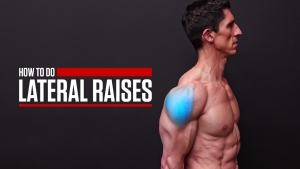
HOW TO TRAIN THE REAR DELTS
Ironically, one of the most overlooked muscle groups is also one of the most important to train. I’m talking, of course, about the rear delts.
Located on the back of your shoulder, the rear deltoid muscle is integral to safe and perfect strength training program.
The rear deltoid muscles play an important role in shoulder mobility and stability.
What’s more, strengthening the rear delts doesn’t just bulletproof your shoulders, but it also improves your performance in other upper body exercises like the Bent Over Row and T-Bar Rows.
In short, it is important to include additional exercises which specifically target the rear delts in your workout routine.
If your shoulder workout is lacking in rear delt exercises, I’ve got you covered.
ANATOMY OF THE DELTOIDS
Before launching into the best rear delt exercises, let’s take a quick moment to review the anatomy of your deltoid muscle group.
This will provide you with greater insight into why these effective exercises are so useful and how they should be performed for optimal results.
Why limit yourself to merely learning how to do an exercise, when you could understand the muscle behind it and the level of its involvement in the exercise?
A deeper understanding of your primary muscles will allow for a stronger mind-to-muscle connection that can result in awesome gains.
In this case, you’re going to learn about the major muscle complex of the deltoids.
It’s essential to understand and implement the mind-to-muscle connection during exercise, something that I always emphasize in my training material. Make sure to make this a priority for every single training session you do!
With all of that said, to get the most out of your shoulder workouts, it is essential to understand how your deltoids work. Again, doing so will help you create a stronger mind-muscle connection and yield better results.
The deltoid muscle is composed of three heads or sections:
- Anterior deltoids
- Lateral deltoids
- Posterior deltoids
All three heads of the shoulder muscle work harmoniously to help you with various motions, yet each still carries its own distinct purpose in developing balanced physiques and remarkable upper bodies.
Let’s start by looking closer at the rear delts then working our way to the front of the shoulder joint.
POSTERIOR DELTS (REAR DELTS)
Have you ever wondered what role your posterior deltoid muscles play in your upper body mechanics?
Your rear delt muscles play an integral role in shoulder extension and external rotation. How do those two actions differ from each other though?
To feel shoulder extension, move your arm behind you in an upwards motion. For a demonstration of shoulder external rotation, rotate your arm away from the center of your body.
Injury prevention is one of the main reasons why it’s important to strengthen your rear delts. By doing so, you’ll be reducing any strain or stress that may have been put on your anterior or front delts. This can help you keep better posture and improve overall shoulder health in the long run.
As you’ll see below, it doesn’t take a lot to strengthen your rear delts. You don’t need a whole collection of posterior deltoid exercise equipment – just the basics of any commercial or home gym.
LATERAL DELTS (SIDE DELTS)
The lateral head of the deltoid, known as the side deltoid muscle, is responsible for abduction movements, which refer to any movement away from your body.
Additionally, it is engaged in medial or inward rotation of your shoulder joint.
When trying to obtain that powerful broad-shouldered shape, the middle deltoid or medial deltoid is an essential muscle group to target.
You can target the lateral delts with exercises like Lateral Raises and the Bent-Over Dumbbell Lateral Raise.
ANTERIOR DELTS (FRONT DELTS)
Finally, we have the anterior deltoid muscle.
Your anterior deltoids are located on the front of your shoulders, and they have a variety of important functions, including:
- Flexion of the shoulder joint
- Horizontal adduction (movement towards the body)
- Medial rotation (inward rotation)
Many people wrongly assume that their chest workouts alone are enough to work on their front delts and build broad shoulders.
Incorporating shoulder workouts into your fitness regimen could be exactly what you need to see serious results in your delts and overall upper body.
If that sounds like a lot, keep in mind that there is no substitute for hard work if you want to make your physique goals a reality.
IMPORTANCE OF THE REAR DELTS
The rear deltoids are a crucial muscle group that many people neglect. Their importance lies in the fact that they provide stability for movements of the shoulder, neck, and spine.
That’s not all they can do. Here are some of the reasons you need to prioritize rear delt training for better results.
POSTURE
Stronger shoulders, especially in the rear delts, will help to keep your shoulders pulled back and down, promoting better posture throughout the day. This is especially helpful if you spend most of your time in front of a computer or sitting at a desk.
SHOULDER STABILITY
When it comes to movements that require stability such as Overhead Presses, your rear delts are the primary muscles that come into play. Strengthening them can help you gain more control over other compound exercises, have better range of motion, and reduce the risk of injury.
BALANCED MUSCLE AESTHETIC
Developing your rear delts can also help to improve not just your overall shoulder development, but also your upper back muscle fibers as secondary muscles by creating balance between all the different parts of your shoulders.
The best example of this is when you want to work on developing that boulder shoulders look.
You don’t want to just train your lateral delts because this is only one angle. You need to also work the rear delts in order to create the full effect.
HOW TO KNOW IF YOU HAVE WEAK REAR DELTS?
Right now, I know some of you are saying, “Jeff, I don’t need to train my rear delts. I do plenty of shoulder exercises like Overhead Presses.”
If that’s the case, your rear delts are probably in dire need of some attention.
But how can we tell for sure?
Try taking this quick test:
LOOK AT YOUR POSTURE
First, you can determine whether you have weak rear delts just by looking at your own posture from the side.
If your shoulders tend to round forward, you most likely have weak rear deltoid muscles.
To be clear, I’m saying that the rounded shoulder is actually causing you to have weak delts because you get an overstretched position of the rear delt that leads to weakness over time.
That imbalance is caused by tightening and shortening of the muscles on the front side of our chest, caused by overworking that front side.
By focusing on solid rear deltoid workouts, you can reverse this issue and you’ll watch your posture improve as a result.
SHOULDER SORENESS
The next thing you’re going to notice is you’ll probably have some combination of muscle tightness, soreness and pain that you can touch through the back of your shoulders.
You’ll have obvious trigger points that you can feel.
And that’s occurring because the weakness that develops in the rear delt is replaced by artificial stability of trigger points and spasms that try to make your shoulder feel more stable because it lacks the actual strength that needs to be there in the first place.
DOES THIS SOUND LIKE YOU?
If one or both of these symptoms hit home for you, don’t worry! There’s plenty that you can do to strengthen your rear delts.
It all starts with you incorporating the best rear delt exercises into your shoulder training programs.
BEST REAR DELT EXERCISES
Guys, it’s time to check out the best posterior deltoid exercises. Not only do I recommend these exercises, but I also personally use them!
One quick note: If your goal is to increase the overall size of your shoulders, build serious muscle mass and see strength gain, it’s important to remember that the rear delts are just one part of the bigger picture.
While you should absolutely focus on rear delt workouts, you also want to target the side delts and the front delts.
Doing so will ensure that you walk away with a balanced and aesthetically pleasing set of shoulders and upper body.
Now, with that said, the rear delt exercises that I’m going to be focusing on aren’t just another set of a Reverse Fly or Reverse Peck Deck.
I’m not going to tell you to go over to the Rear Delt Fly machine and perform something in the 5-10 rep range.
There’s nothing wrong with the motion of the Reverse Fly because we know the function of the rear delt is to get that arm back behind our body.
The problem comes in if you always do it in the straight arm fashion, which limits the amount of activation you’re getting with the rear delt. You’re limiting the capacity of the rear delt to perform the lift.
The rear delt exercises I’m going to feature below maximize both function and effectiveness.
ABDUCTION ROW

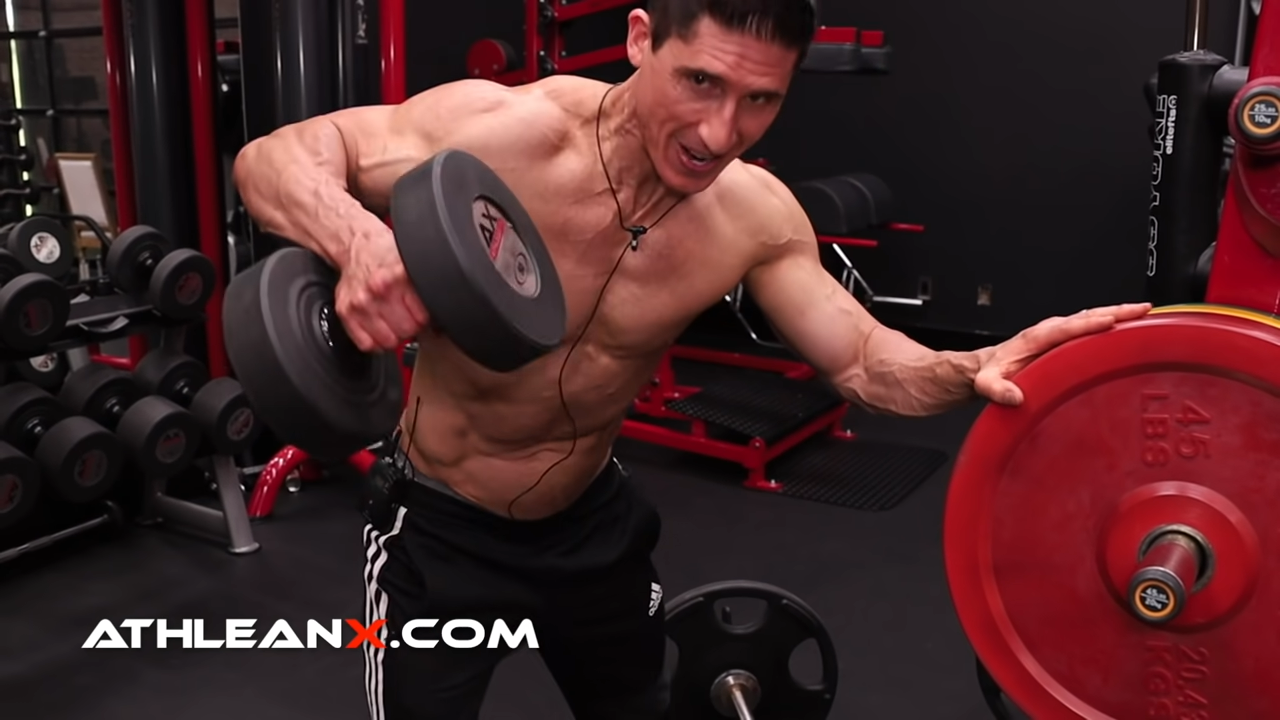
HOW TO DO THE ABDUCTION ROW:
- For the dumbbell rear delt Abduction Row, initial position is in a standing position feet shoulder width apart with feet flat on the ground. Select a dumbbell that is an appropriately heavy weight for you, holding it with an overhand grip.
- Place yourself at a 30 degree forward angle while propping yourself against an incline bench to maintain balance if necessary. Move your feet shoulder width apart. Let the dumbbell hang right in front of your thigh.
- Now, row and abduct simultaneously away from yourself to raise the dumbbell to about shoulder level.
- You can use heavier weights with this exercise for progressive overload, so stay within the six to eight rep ranges. Keep your core tight throughout the exercise.
MAKE MAKES IT EFFECTIVE: This excellent exercise targets the rear delts with dumbbells while minimizing the contribution from the lats. Again, this is an exercise that you want to use heavy dumbbells for, but be responsible and smart about how much weight you use here. Unilateral exercises like this are great for preventing and treating muscle imbalances and creating balanced shoulders. This is one of the best exercises with dumbbells for the rear delts.
SEATED REAR DELT ROW

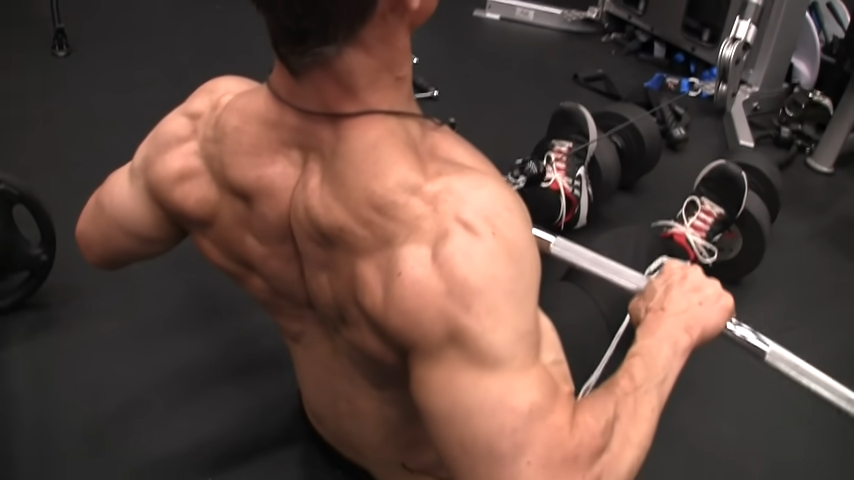
HOW TO DO THE SEATED REAR DELT ROW:
- For the starting position, sit up nice and tall, keeping an upright posture on a cable pulley machine with a long bar cable attachment.
- Move your arms out wide and focus on getting the upper arms back behind your body as far as possible. Keep the elbows high. They’re not tucked in down at your sides.
- Drive them back toward chest height and you can see that rear delt is all fired up.
- You can use a traditional Seated Cable Row station on a cable machine, or you can use the same set-up I have above.
MAKE MAKES IT EFFECTIVE: The tighter to your side your elbows are, the more activation of the lats in favor of the rear delt. The way we want to get our rear delt to take over and do as much of the work as possible is to get those elbows out high. Get out of adduction and let the rear delts do what they do best: the extension of the arm. Keep in mind that this is another cable movement that allows you to use heavy weight.
STANDING REAR DELT ROW

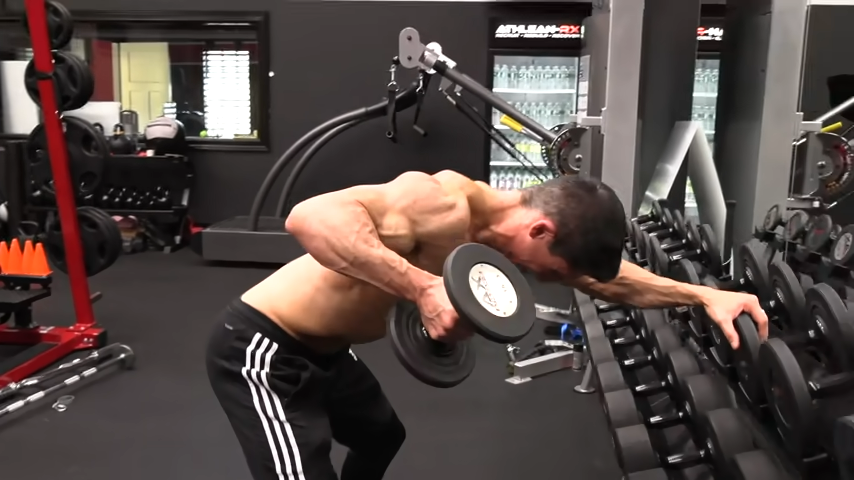
HOW TO DO THE STANDING REAR DELT ROW:
- This is another type of rowing movement that you can use to develop the rear delts. This rowing exercise emphasizes the backward extension of your arm and encourages external rotation.
- Grab a single dumbbell with an underhand grip. As you pull up the weight towards shoulder height, also try to rotate your hand with motion as if pointing at somebody behind you with your thumb.
- Again, it’s recommended to use either a flat bench or incline bench depending on your height.
MAKE MAKES IT EFFECTIVE: By externally rotating your arm and extending the elbow behind your body in this shoulder movement, you will be able to target the rear delts with precision. This is a great exercise for anyone interested in building muscle mass and strength in the shoulders.
LOW-TO-HIGH FACE PULLS

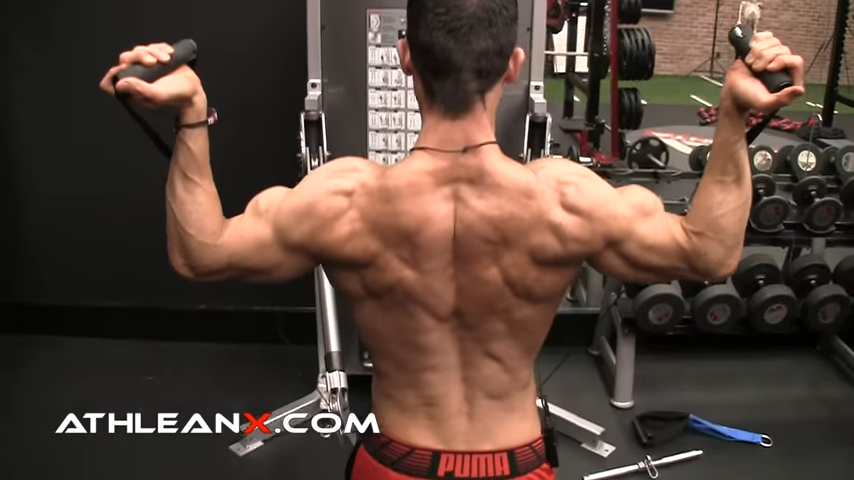
HOW TO DO LOW-TO-HIGH FACE PULLS:
- Begin with your thumbs together and internally rotated arms, gripping the cable handles with an underhand grip.
- Take your arms up, scoop them out, and then back. Focus on making a “W” with your arms.
- Keep a slight bend in your elbow throughout the movement.
MAKE MAKES IT EFFECTIVE: This is hands down one of my all-time favorite isolation exercises. Face Pulls are great because they specifically target the rear delts increasing shoulder strength and helping to reverse the tension that naturally builds up in the front of our upper body. Since it alleviates the anterior tightness, it’s going to support everyday movements like picking up groceries, typing at your desk, etc.
BODYWEIGHT BACK WIDOWS


HOW TO DO BODYWEIGHT BACK WIDOWS:
- Here’s a rear delt exercise that you can do at home. For the exercise setup, begin by lying flat on the ground.
- Dig your elbows close to you and press away from the ground beneath, lifting your chest as high off of it as possible.
- Concentrate on pushing yourself up with every ounce of upper body strength you can to reach maximum elevation!
MAKE MAKES IT EFFECTIVE: This bodyweight exercise creates a powerful contraction in your rear delts, which is precisely what you need to lift yourself from the ground. These bodyweight movements pack an intense punch, and are great for creating deep deltoid muscle definition.
W RAISE


HOW TO DO THE W RAISE:
- The main goal of the W Raise is to… you guessed it, create a “W” with your arms. From a standing position, bend slightly at the hips, holding a pair of lighter dumbbells.
- Bring the dumbbells up beyond shoulder height (think Reverse Fly) and as you get to the top, squeeze the rear delts before lowering the dumbbells.
MAKE MAKES IT EFFECTIVE: When you perform a W Raise, you will hit two of the major functions of the rear delts: extension of the arm back behind the body and horizontal abduction of the arm back behind the body, both healthy movement patterns for the rear delts.
A training regimen for rear delts is essential for injury prevention and creating balance in your shoulder development.
By focusing on rear deltoid exercises one or two times per week, you can provide the stimulus the rear delts require for muscle growth, strength, and injury prevention.
Make sure to use a weight that is appropriate for you and, as always, focus on correct form and consistency to get the best results.
If you don’t already have a training program, I can help out with that! Check out our ATHLEAN-X programs to see which one best fits your goals and fitness level!

- The deltoid muscle is composed of three heads or sections: anterior deltoids (front shoulder muscle), lateral deltoids (side shoulder muscle), and posterior deltoids (back shoulder muscle).
- Strong rear delts keep your shoulders pulled back and down, promoting better posture throughout the day. They will also help with stability while preventing strains and injuries. Not to mention, your rear delts help to achieve a balanced looking upper body.
- If you’re wondering if you have weak delts, here are two signs: Your shoulders tend to round forward and you have constant soreness across your shoulders.
- I’d recommend using a combination of light weight and heavy weight exercises to strengthen your rear delts and reverse the tightness from the front of the body.
- The Abduction Row, Seated Rear Delt Row, and Standing Rear Delt Row are all favorite exercises where you can use heavier loads.
- The Low-To-High Face Pulls, Bodyweight Back Widows, and W Raise are all light weight or bodyweight exercises.
- Select one of each type of exercise and aim to complete a set 2-3 times each training session. As for repetitions, with the lighter weights, you can use the standard 8-12 reps. If you want to fatigue the muscle, you can go as high as 20 reps.
- For heavy weight exercises, I wouldn’t recommend 10-12 reps. I want you to stay within the 5-10 range.
REAR DELTS FAQS
The best way to hit the rear delts is by performing exercises that involve horizontal abduction, such as Reverse Flyes and Bent-Over Lateral Raises. You can also activate the rear delts by performing the Dumbbell Row. These exercises can be performed using a pair of dumbbells, resistance bands, or cable machine handles.
One note with the Dumbbell Row: There’s no need to use heavy dumbbells like you see a lot of guys doing. The focus should be on the quality of the movement. To ensure you’re maximizing this, I’d say grab a light dumbbell or a medium dumbbell and move slowly through the exercise. Focus heavily on the contraction during the eccentric portion of the lift.
Rear delt flyes can be performed with either a pair of dumbbells, resistance bands, or a cable machine. If using dumbbells or exercise bands, you can choose to perform the flyes while standing or laying on an incline bench.
You can also use an incline bench for the cable machine version, but you'll need to drag a bench over and then crisscross the pulley handles. The extra work is why most people do the movement while standing at the cable machine.
Begin by holding a dumbbell in each hand, with your palms facing inward. With your chest out and shoulders back, lean forward at the waist and raise your arms out to the side, leading with your elbows. Hold for a brief moment and then slowly move to the starting position.
Pull ups primarily work your back and biceps, but they can also be used to slightly increase the activation of the rear delts. To do so, you’ll need to slightly modify your form by bringing your elbows closer together when pulling yourself up. This will help engage the rear delts more fully during the exercise.
To maximize muscle growth and strength gain in your rear delts, you should focus on performing compound exercises and then supplementing your decent strength training routines with exercises that involve the horizontal abduction movement pattern. Some of the best exercises for rear delt growth include reverse flyes, bent-over lateral raises, and prone incline lateral raises.
Additionally, you should keep your rep range moderate (8-12 reps) and focus on using a weight that allows you to complete all the prescribed reps with proper form. Again, this doesn’t mean you need to use a heavier weight. Instead, focus on a lighter weight or moderate loads. You should be able to effectively lift the weight with control from top to bottom.
REFERENCES

Jeff Cavaliere M.S.P.T, CSCS
Jeff Cavaliere is a Physical Therapist, Strength Coach and creator of the ATHLEAN-X Training Programs and ATHLEAN-Rx Supplements. He has a Masters in Physical Therapy (MSPT) and has worked as Head Physical Therapist for the New York Mets, as well as training many elite professional athletes in Major League Baseball, NFL, MMA and professional wrestling. His programs produce “next level” achievements in muscle size, strength and performance for professional athletes and anyone looking to build a muscular athletic physique.

















